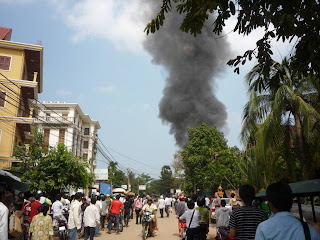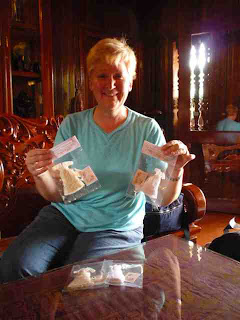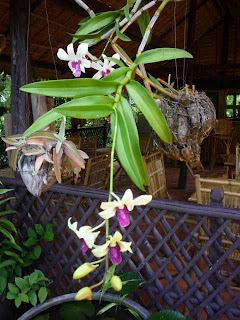My staff members at the Bloom guesthouse told me banana sellers in Phnom Penh took advantage of the tragedy in Phnom Penh and raised the prices of bananas in the city. Cambodians offer bananas and light incense (3 or 5 sticks, different from the 2 sticks that the Chinese offer) and candles to pray for the dead. Everyone bought bananas, even in Siem Reap, to pray that those who died in the stampede will go to heaven.
So these banana sellers in Phnom Penh were selling a bunch of bananas for 15,000riels or even 30,000riels (US$7.50). The normal price is 1500riels ($0.40) or 2500riels. Even in Siem Reap, the price went up, to 5,000 (US$1.25) or 7,000 riels per bunch.
Kagna's sister-in-law, who is a fruit seller in Psar Leu market here in Siem Reap said, "Why these people like this?" She believes "do good, get good" so will not raise her prices from the usual 2500 riels. Everyone is disgusted with the opportunistic merchants. But even at those prices, the bananas were sold out in the city.
Cambodians are finding it hard to understand how so many people can die in such a short time. In just 6 hours, more than 300 people died (latest reports put the figure closer to 400). Kagna says even in Pol Pot's time, not so many people died in such a short time (I don't know if this is true). She said Prime Minister Hun Sen "cry and cry" on TV and that during the six hours, he was exhorting the people on the bridge "don't run, don't run." She said he was beamed live on TV and they broadcast his message on loudhailers around the bridge.
Some theories have emerged. Some say it is because it is the year of the Tiger and tigers like meat and blood, so it is a year for disaster (err...not a very good theory if you ask me).
Others say it was caused by agents who are opposed to the government so that the Cambodian people will blame the government for its ineptitude (err...also not a very good theory, in my view, because the people who shouted must have been amongst the crowd, so risked their lives as well. Unless people think these "secret agents" had a way of escaping after causing the panic). But the government has said it will find and punish those responsible for shouting that the bridge was about to collapse.
Another theory is the panic was caused by Cambodian "hooligans" who like to play a game. The game involves linking arms and moving the human chain altogether forwards and then backwards. People will then fall, causing laughter and cries. Usually the youth do this on the streets during the Water Festival.
But maybe the simplest explanation is the right one.
Occam's Razor is a principle that recommends selecting the competing hypothesis that makes the fewest new assumptions.
Cambodians are not the only ones to have experienced a stampede.
This study found a total of 215 human stampede events were reported from 1980 to 2007, resulting in 7069 deaths and at least 14,078 injuries.
There are many things that can cause a stampede. When the Brooklyn Bridge just opened, a woman tripped, which contributed to fears that the bridge would collapse. "As she lost her footing another woman screamed, and the throng behind crowded forward so rapidly that those at the top of the steps were pushed over and fell in a heap." (abstract found in the
New York Times.)
In 2005, 1000 people died in the
Baghdad Bridge Stampede . There were rumours of a suicide bomber. Interior Minister Bayan Baqir Solagh
said that one person "pointed a finger at another person saying that he was carrying explosives...and that led to the panic".
In 1989, 96 people --all fans of Liverpool F.C.-- died in the
Hillsborough disaster. In 2007, 3 people died and 30 were injured in Chongqing, China, when a supermarket offered 20% discount on cooking oil. And in 1896, 1389 people were killed in a crush as people tried to get presents during the Coronation of Russian Tsar Nicholas II. (All these records can be found on
http://en.wikipedia.org/wiki/Stampede).
So I don't think the stampede was caused by enemies of the state. We still do not know what caused it, but it could be as simple as a one person suggesting the bridge could collapse. If enough people hear and believe him, that would be enough to cause a panic.
For me, the important thing is that the authorities learn from this tragedy. Stampede can be prevented by more organised crowd control, barriers and preventing extreme density of people.
This interesting
Slate article, on "How not to get trampled at [Obama's] Inauguration" tells you the warning signs of an imminent crowd crush and what to do in such a situation. Here are some pointers:
1. There needs to be communication - with barriers, signs, or loudhailers. "Crowds are rarely belligerent, but they can become deadly if, for example, there's no way to announce that someone has fallen down and everyone must take a step back."
2. You also need space around you, and the article suggests no more than four people per square meter. "Otherwise, if someone jostles you, you won't have room to stick a foot out to stabilize yourself. If you fall, other people may trip over you, creating a pileup. Meanwhile, the rest of the crowd will continue to surge forward, unaware of your situation, and the pressure will build."
3. If you do feel like you are being touched on all four sides, you need to move to the margins. Try to move sideways. "After that, the last opportunity to escape may be when you feel shock waves travel through the crowd. This happens when people at the back push forward, but the people at the front have no where to go. If you feel the crowd sway like this, you are in serious danger. Wait until the crowd stops moving and then inch your way sideways and backward, zigzagging to safety. Just as you might swim back to shore in the ocean, try to navigate during the pause between waves."
























































